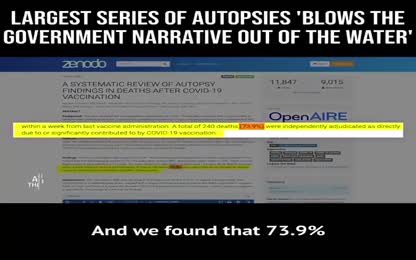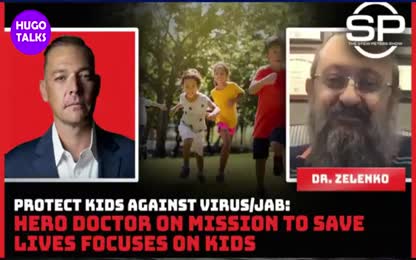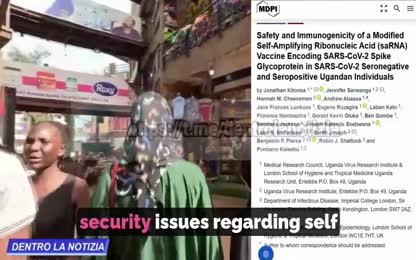Advertisement
The Science of Wearing Masks & Respiratory System Coronavirus Covid-19 Lockdowns Quarantine Pandemic
The Science of Wearing Masks & Respiratory System Coronavirus Covid-19 Lockdowns Quarantine Pandemic
Armando Hasudungan Youtube Channel
https://www.youtube.com/watch?v=qDrV33rZlyA
https://www.ncbi.nlm.nih.gov/pubmed/16441251
https://www.oatext.com/Evaluation-of-rebreathed-air-in-human-nasal-cavity-with-N95-respirator-a-CFD-study.php#Article
New studies indicate that close & prolonged contact is required for #COVID19 transmission.
https://threadreaderapp.com/thread/1257392347010215947.html
- Category: Mass Mind Control,MartialLaw/Lockdown/StateOfEme,Vaccine / Mandatory Agenda,Virus / Bacteria / Sickness
- Duration: 24:30
- Date: 2020-05-13 10:50:02
- Tags: coronavirus covid-19 pandemic quarantine lockdown
4 Comments
Video Transcript:
One of the major reasons why you're alive is oxygen. So take a deep breath in. Also important to understand that carbon dioxide and pH is also very much related. If we have an increase in carbon dioxide, this will actually cause a decrease in pH, which means that it will make the blood acidic. If we have a decrease in carbon dioxide, this will make the blood much more alkaline. So an increase in pH. If we have an increase in carbon dioxide, this will actually cause a decrease in pH, which means that it will make the blood acidic. We put surgical masks on sick people to protect healthy people around them. They serve an emotional or psychological benefit for people because people feel more protected. The reality is they don't really provide us with protection. So there are basically two types of masks. There's surgical masks and there are masks called N95 respirators. Let's start with the surgical masks. In a hospital setting, I'm a surgeon, I do real surgery. When I go into the operating room and I put a surgical mask on, it is not to protect myself from getting sick in a sterile environment. It is to protect the patient that I'm operating on in case I spit while I'm talking or cough or sneeze. Surgical masks that you see all over television and video, they do not block out the tiny particle size of coronaviruses or influenza virus. They don't. Those viruses can pretty much go right through those masks. There's a lot of confusion among people and misinformation surrounding face masks. Can you discuss that? The masks are important for someone who's infected to prevent them from infecting someone else. Now, when you see people and look at the films in China and South Korea, whatever everybody's wearing a mask, right now in the United States, people should not be walking around with masks. You're sure of it because people are listening really, no, closely to this. Right now, people should not be walking. There's no reason to be walking around with a mask. When you're in the middle of an outbreak, wearing a mask might make people feel a little bit better and it might even block a droplet, but it's not providing the perfect protection that people think that it is. And often, there are unintended consequences. People keep fiddling with the mask and they keep touching their face. So, I think it's a bit of a problem. I think it's a bit of a problem. I think it's a bit of a problem. I think it's a bit of a problem. I think it's a bit of a problem. I think it's a bit of a problem. I think it's a bit of a problem. I think it's a bit of a problem. I think it's a bit of a problem. I think it's a bit of a problem. I think it's a bit of a problem. I think it's a bit of a problem. I think it's a bit of a problem. I think it's a bit of a problem. I think it's a bit of a problem. I think it's a bit of a problem. I think it's a bit of a problem. I think it's a bit of a problem. I think it's a bit of a problem. I think it's a bit of a problem. I think it's a bit of a problem. I think it's a bit of a problem. I think it's a bit of a problem. I think it's a bit of a problem. I think it's a bit of a problem. I think it's a bit of a problem. I think it's a bit of a problem. I think it's a bit of a problem. I think it's a bit of a problem. I think it's a bit of a problem. I think it's a bit of a problem. Today also the CDC is announcing additional steps Americans can take to defend against the transmission of the virus. From recent studies we know that the transmission from individuals without symptoms is playing a more significant role in the spread of the virus than previously understood. So you don't seem to have symptoms and it still gets transferred in light of these studies. The CDC is advising the use of non-medical cloth face covering as an additional voluntary public health measures. So it's voluntary. You don't have to do it. They suggested for a period of time. But this is voluntary. I don't think I'm going to be doing it. Protect yourself and your loved ones. Here are the six steps to wearing the N95 mask. Step 6. Perform a fit check by breathing in and out. While breathing out, check for air leakage around your face. In summary, when it comes to viral load in the air, the data suggests that the concentration of suspended virus in the air increases from almost no virus in uncrowded public places. The CDC use and isolation rooms to a little more encrowded outdoors areas, even more in medical staff rooms and patient toilets to a lot in staff changing rooms where they take off their protective apparel. About the X-Gritory system. The body collects waste such as toxins, waste products, and carbon dioxide, which result from the tabalism in the body. The X-Gritory system removes these toxins and waste. In addition, the X-Gritory system regulates your amount of fluid and salts in your body. All of these functions help to maintain the homeostasis of your body. The components of the X-Gritory system include your lungs, skin, and kidneys. The lungs primarily excrete carbon dioxide, which is a poisonous gas for the body, which is a poisonous gas for the body. One of the major reasons why you're alive is oxygen. So, take a deep breath in. When you breathe in, you take an oxygen present in the air. The air then passes through your nostrils. There are tiny hair present in your nostrils that obstruct all the dust particles. Then the air travels through the windpipe, also called the trachia, which enters the air inhaled. The trachia branches out to two tubes called bronchi, where tiny hair called cilia move back and forth, moving the mucus inside. The mucus is a sticky substance that collects germs and other particles that might harm the lungs. For bronchi, then carry air into each lung. The right lung has three lobes, whereas the left lung has two lobes. The left lung is slightly smaller in size, to give space to the heart. These lobes are filled with small and spongy air sacs called alveoli, where the exchange of oxygen and carbon dioxide happens. It is here that blood picks up oxygen and let's go off carbon dioxide. There are three types of respiration to be precise. External, internal and cellular respiration. External respiration is the one which occurs at the nasal level. The oxygen from the surrounding air is brought inside the nasal cavity and the carbon dioxide is given out. This is called external respiration, which involves interaction with the exterior world. In other words, external respiration is sometimes used synonymously with breathing. Next in the list is internal respiration. As the name suggests, the one which occurs internally or inside the body to be precise. When the oxygen from the air reaches the lungs, it gets transported to the blood. Similarly, carbon dioxide from the blood is given out in the lungs, which travels later to the nasal area. The oxygen then travels throughout the body and is delivered to the cells, and the carbon dioxide is similarly taken away. This exchange of gases that occurs inside the lungs, blood and the cells is called internal respiration. And last on the list is cellular respiration. Don't we know this? The name says it all. The process in which oxygen is used to break down the food molecules by the cells is called cellular respiration. In this video, we're going to look at gas exchange. So essentially, we're looking at how gases are transported around our body, the oxygen and carbon dioxide. And how our tissues receive this oxygen and how our lungs receive the carbon dioxide so we can exhale it. So let's just begin this journey with the lungs here, and here I'm drawing the heart as well, and also tissues. So here is our tissue, our heart, and our lungs. After the tissue has utilized or used oxygen, the blood will then return to the heart. The blood returning to the heart is deoxygenated blood, because it contains, you can say, low oxygen. The oxygen has been used by the tissue. Now the blood leaving the tissues in order will be venules, veins, and then as it enters the heart, it can either enter through the inferior or superior vinaigabha. So we'll enter the heart, and then from the heart, the heart will pump this deoxygenated blood through the pulmonary artery. So why is it called deoxygenated blood? Well, it's because we have more concentration. You can say of carbon dioxide compared to oxygen, or it's properly said we have higher partial pressure of carbon dioxide compared to oxygen. That is why they are deoxygenated. As the deoxygenated blood enters the lungs, the blood will offload the carbon dioxide, and then the lungs will reoxygenate the blood, essentially putting in more oxygen into the blood, forming oxygenated blood. And this oxygenated blood supply will then go back to the heart through the pulmonary vein. So if we look at the partial pressure of oxygen and carbon dioxide, again we can see that we have higher amounts of oxygen compared to carbon dioxide. So as this pulmonary vein brings this oxygenated blood back to the heart, the heart can then pump this oxygenated blood to tissues or around our body. First of all, through the aorta, then the arteries, then the arterials, where the arterials within form compilaries, and then into tissues. And if we look at the partial pressure of gases in this oxygenated blood supply, we can see that we have higher amounts of oxygen compared to carbon dioxide. And so within the tissues, again we have oxygen being offloaded into the tissues so the tissue can use it as energy and the carbon dioxide release back into the blood as a byproduct. And then you have another mechanism where the carbon dioxide can enter the red blood cell and actually attach with hemoglobin to form carboeomeno hemoglobin. So now if we're going to look at the ways carbon dioxide is transported in the blood, we know that there are at least three mechanisms. The first is that carbon dioxide can dissolve in plasma, about 10% of it, which is this one. Or carbon dioxide can react with a hemoglobin within red blood cells to form carbon carboeomeno hemoglobin. And this is about 20% of the carbon dioxide being transported this way. And the last, which is the majority, which is the major mode of transportation for carbon dioxide is as bicarbonate in plasma. And this is about 70% of the carbon dioxide. But again, forming bicarbonate, there are two ways. One is that it can be formed in red blood cells, which is a fast process, or it can be formed in the plasma itself, which is much slower. Also important to understand that carbon dioxide and pH is also very much related. If we have an increase in carbon dioxide, this will actually cause a decrease in pH, which means that it will make the blood acidic. If we have a decrease in carbon dioxide, this will make the blood much more alkali, so an increase in pH. Why is this? Well, first of all, let's just pretend that we have more carbon dioxide. If we have more carbon dioxide, this will shift the reaction to form more bicarbonate and hydrogen ions. If we have more hydrogen ions, this just means that it will be more acidic. Also important to understand that carbon dioxide and pH is also very much related. If we have an increase in carbon dioxide, this will actually cause a decrease in pH, which means that it will make the blood acidic. If we have a decrease in carbon dioxide, this will make the blood much more alkali, so an increase in pH. Let's first begin by looking at how carbon dioxide is transported from the blood back into the alveolus, into the lungs, so that we can exhale the carbon dioxide. If you remember the previous diagram, some of the carbon dioxide is transported through plasma, so this carbon dioxide can just enter the alveolus. A majority of the carbon dioxide is actually transported, if you remember, in the blood as bicarbonate. This bicarbonate can react with hydrogen ions in the blood and through a slow process, form as an end-product carbon dioxide and water. The carbon dioxide can then just enter the alveolus. Of course, some of this, actually a lot of it, or however much, of this bicarbonate in plasma can actually enter the red blood cells through a transporter, which will bring out chloride ions in exchange. Within the red blood cell, bicarbonate can react with hydrogen ion, and through a fast process, and with the help of the enzyme, carbonic and hydrase, the bicarbonate and hydrogen reaction can form carbon dioxide and water. It's fast compared to the outside because of the enzyme present, and then this carbon dioxide can then just exit the red blood cell and enter the alveolus. Finally, you remember that some of the carbon dioxide is transported in the blood bound to hemoglobin as carboeumino hemoglobin. This will disassociate, and then the carbon dioxide, after it's disassociated with hemoglobin, can then enter the alveolus. Now we have a lot of the carbon dioxide in the alveolus. Our body will exhale this carbon dioxide and then we'll inhale oxygen. This video is the Facebook Armando Hasurigan. In this video, we are going to look at control of respiration. Now, the medillary respiratory centers are control respiration. The medillary respiratory centers are made up of the ventral and dorsal groups. The ventral group is responsible for the rhythm city you can say of breathing. But the main regulator or influencer of respiration will be the peripheral chemoreceptors, which are located in the carotid anionotic bodies. They detect changes in the blood, chemical changes in the blood. So for example, if they detect a decrease in oxygen, a decrease in blood pH, which means an increase in hydrogen ions, and an increase in op and CO2, this will stimulate or trigger the chemoreceptors located here in the carotid bodies and anionotic bodies, and they will stimulate these chemoreceptors to stimulate the respiratory center. And so when the respiratory center is stimulated, there will be a quicker respiratory rate. So you will breathe in and breathe out quicker. And so you can breathe in more oxygen and you can breathe out more carbon dioxide to neutralize everything. There are also chemoreceptors located in the medulla known as central chemoreceptors. The medulla is chemoreceptors do exactly the same thing. They can detect changes in pH. A decrease in pH for example, an increase in CO2 will stimulate the chemoreceptors to stimulate the respiratory center so that you could breathe faster. And thereby breathing out more carbon dioxide and inhaling more oxygen. And so you can breathe out more carbon dioxide and inhaling more oxygen. And so you can breathe out more carbon dioxide and inhaling more oxygen. And so you can breathe out more carbon dioxide and inhaling more oxygen. And so you can breathe out more carbon dioxide and inhaling more oxygen. And so you can breathe out more carbon dioxide and inhaling more oxygen. And so you can breathe out more carbon dioxide and inhaling more oxygen. And so you can breathe out more carbon dioxide and inhaling more oxygen. And so you can breathe out more carbon dioxide and inhaling more oxygen. Also important to understand that carbon dioxide and pH is also very much related. If we have an increase in carbon dioxide, this will actually cause a decrease in pH, which means that it will make the blood acidic. If we have a decrease in carbon dioxide, this will make the blood much more alkaline. So it increase in pH. So what's the take home message? If you're in close contact with the family member and you're isolated together, your attack rates are above 70%. If you're together with the family member until they're quarantined, then your attack rate is around 10%. If you have face-to-face contact to a laboratory confirmed case for at least 15 minutes, then your attack rate is somewhere around 5%. And if you're a low risk contact, if you had less than 15 minutes of face-to-face interaction, then your risk of getting infected is very low. And if you're a low risk contact, if you had less than 15 minutes of face-to-face interaction, then your risk of getting infected is very low.









 Donate
Donate







